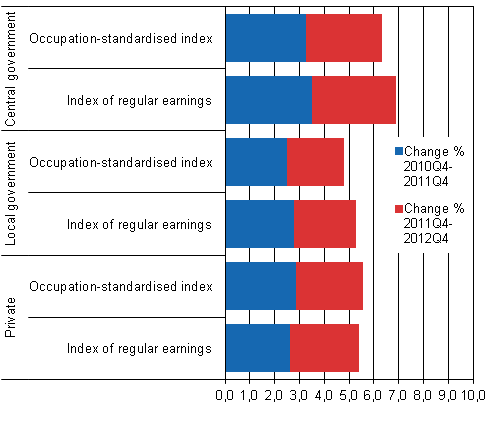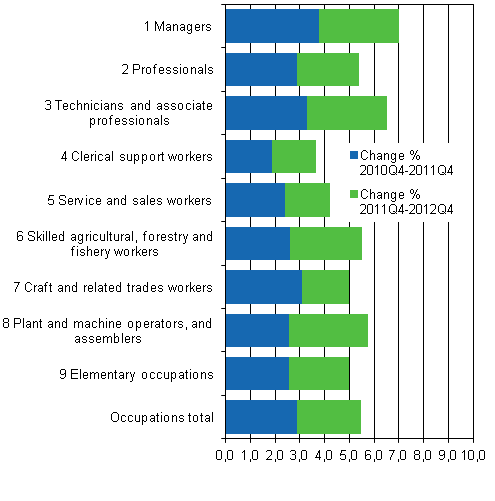Change in occupational structure raises average earnings in the public sector
The growth in occupations requiring more demanding and higher education raises the average earnings of wage and salary earners in the central and local government sectors in addition to pay rises. From 2010 to 2012, the change in the occupational structure has accelerated the development of average earnings by two to three decimals both in the central and local government sectors. In the private sector, the effect of the change in the occupational structure on average earnings has varied by industry. The release of the Index of wage and salary earnings for the third quarter of 2013 now includes data on earnings development standardised with the main category of occupation. In the future, these data are published once a year.
Figure 1. Annual change in earnings in 2010 to 2011 and 2011 to 2012 by employer sector according to the index of regular earnings and the index standardised with the main category of occupation

The statistics now released by Statistics Finland that describe the effects of the change in the occupational structure are based on a report commissioned by the Information Committee on Cost and Income Developments. In this report, a new index was developed based on the index of regular earnings 2010=100, where the shares of the main categories of occupation for the wage and salary earner group of each index were standardised. There are ten of these main categories, from managers to other workers. Detailed definitions of the main categories of occupation are available on Statistics Finland’s pages on the Classification of Occupations at http://tilastokeskus.fi/meta/luokitukset/ammatti/001-2010/index_en.html.
As the level of education rises, a shift will also occur in the occupational structure towards more demanding occupations. For instance, under the main categories of professionals and managers, employees often have an upper level university degree and the income level is higher in these occupations than on average. As the share of these occupations increase in a certain employer sector, the average earnings of all wage and salary earners will rise faster. This development is most clearly visible in the earnings development of central and local government. If the index of wage and salary earnings and the index of regular earnings had been calculated from 2010 to 2012 by eliminating changes in the occupational structure, the rise in these indices would have been around one-half of a percentage point slower over this period.
In the private sector, the effect of the occupational structure on pay development has varied by industry. In several branches, the change in the occupational structure has accelerated the rise in average earnings, but in some industries, it has had the opposite effect. In general, personnel decreases in these industries have lowered the share of upper-level employees and thus the share of higher paid employees in the occupational structure has diminished.
Figure 2. Annual change in earnings in 2010 to 2011 and 2011 to 2012 according to the index standardised with the main category of occupation, employer sectors in total

The annual change in earnings standardised with the main category of occupation has developed fastest in the occupational group of managers and technicians and associate professionals and slowest in the occupational group of clerical support workers (Figure 2). When the annual changes are viewed by employer sector, the fast annual development of managers and technicians and associate professionals and the slow annual development of clerical support workers become particularly emphasised in the private sector. In the local government sector, the earnings development has been faster in the occupational groups of upper-level employees than in the other occupational groups. Employer sector-specific data on the index standardised with the main category of occupation can be found in the database table of the Index of wage and salary earnings.
Source: Index of wage and salary earnings 2013, 3rd quarter. Statistics Finland
Inquiries: Anu Uuttu 09 1734 2322, Harri Nummila 09 1734 3235, palkat.indeksit@stat.fi
Director in charge: Hannele Orjala
Updated 15.10.2013
Official Statistics of Finland (OSF):
Index of wage and salary earnings [e-publication].
ISSN=1798-7814. 3rd quarter 2013,
Change in occupational structure raises average earnings in the public sector
. Helsinki: Statistics Finland [referred: 24.12.2025].
Access method: http://stat.fi/til/ati/2013/03/ati_2013_03_2013-10-15_kat_001_en.html

